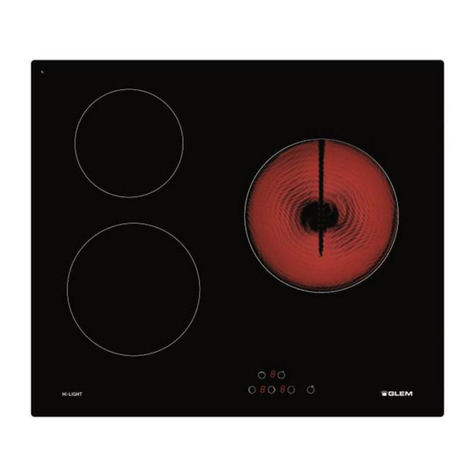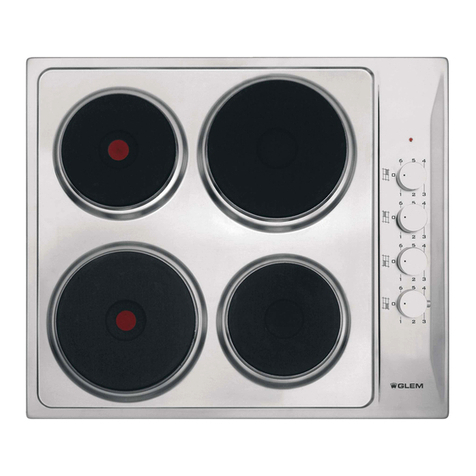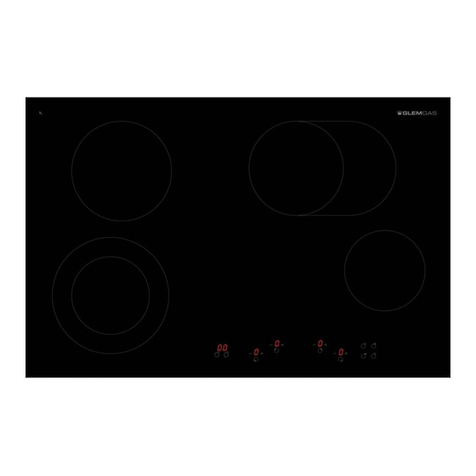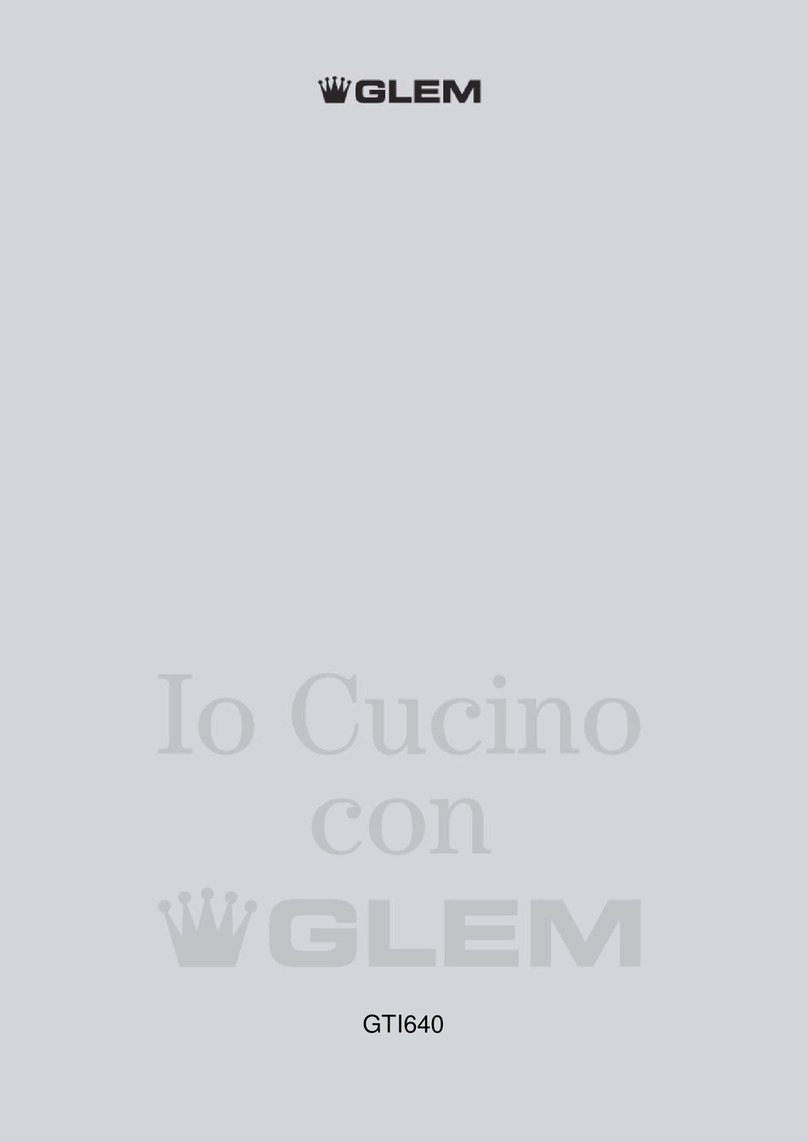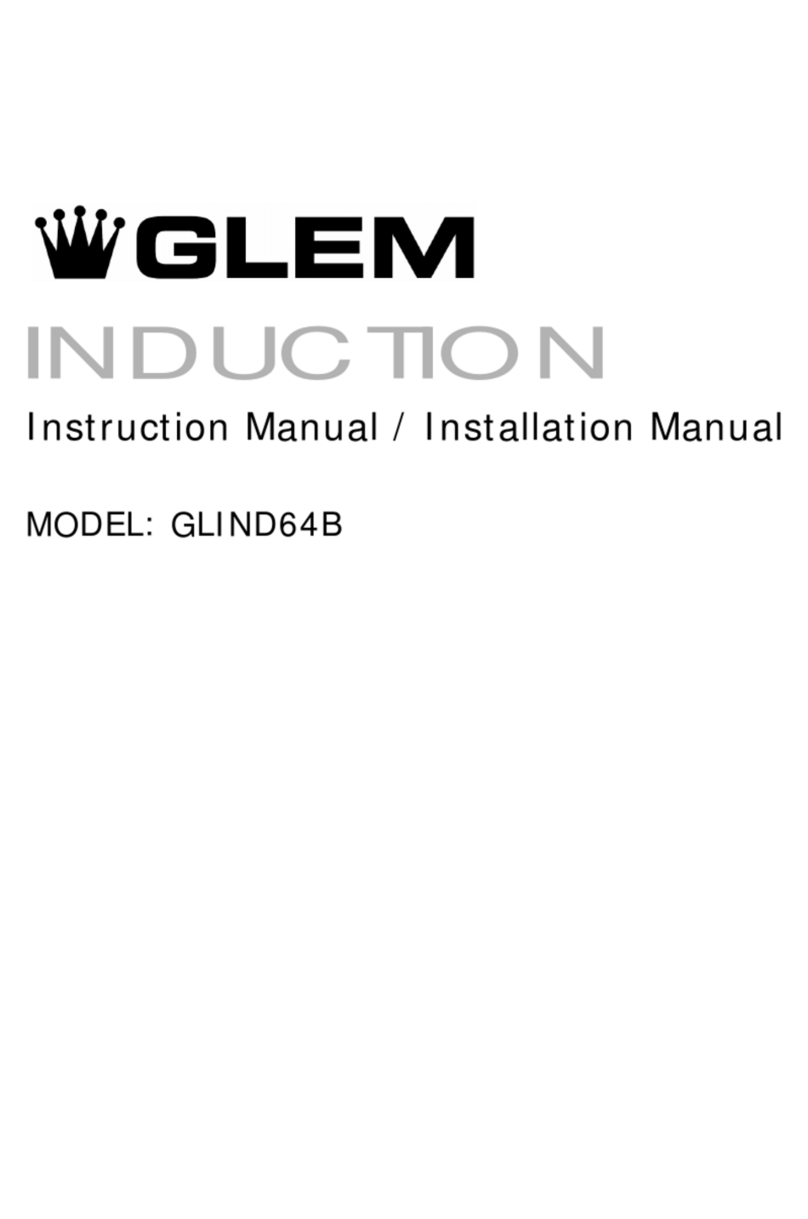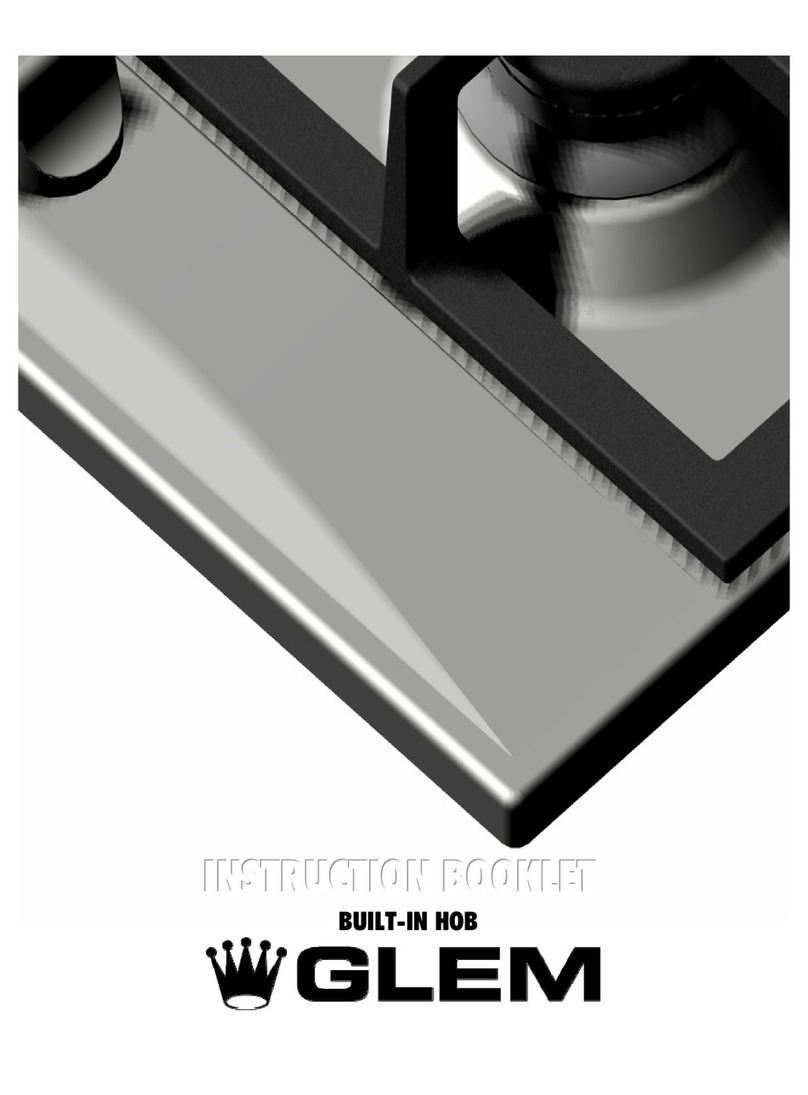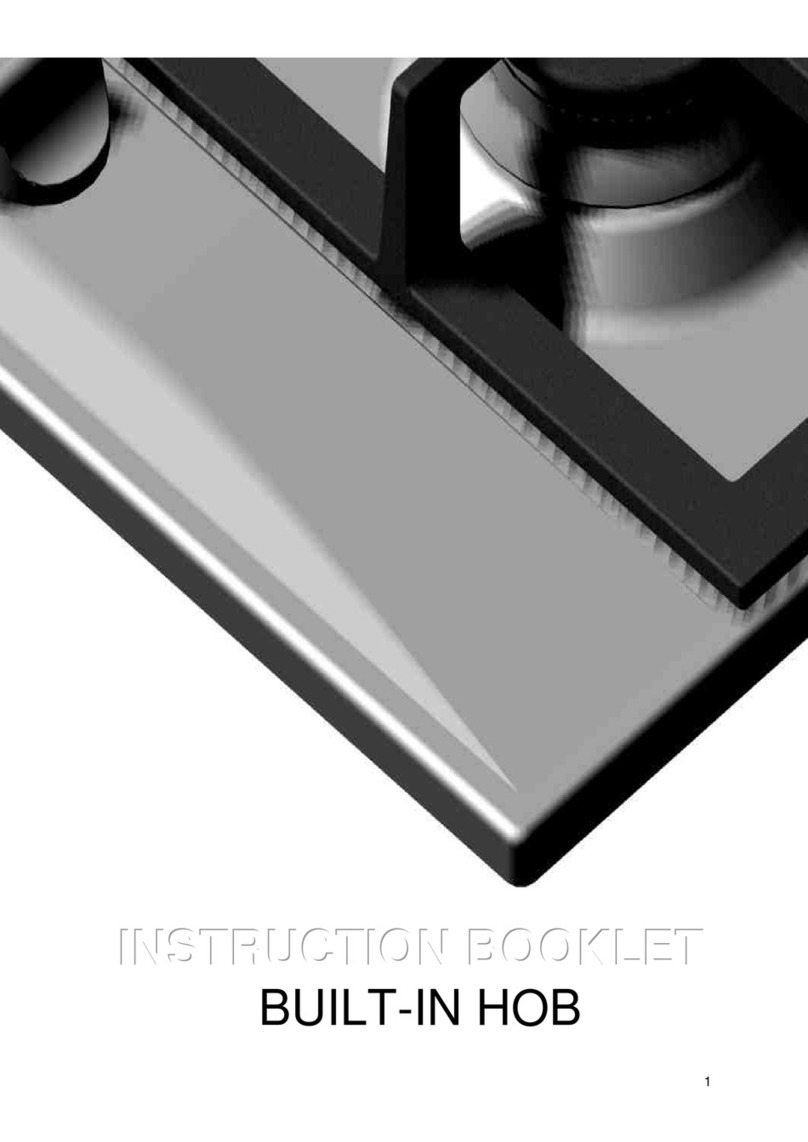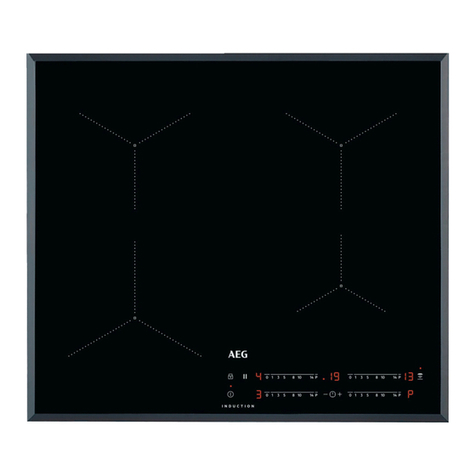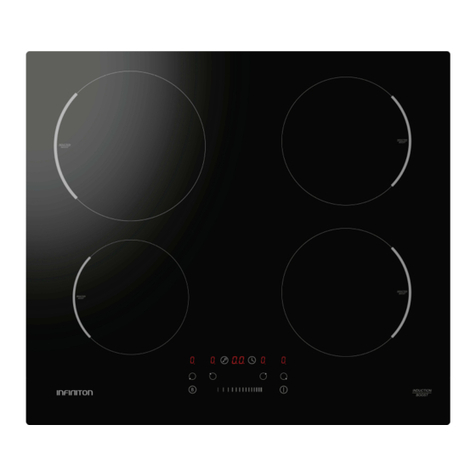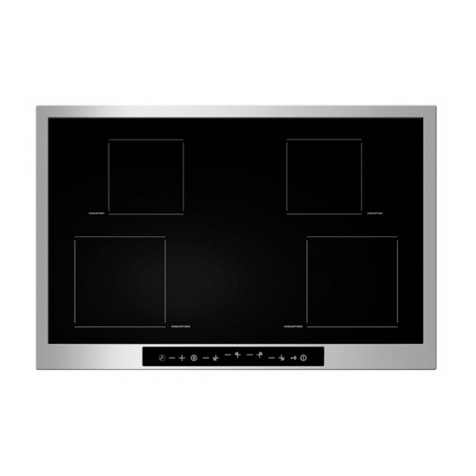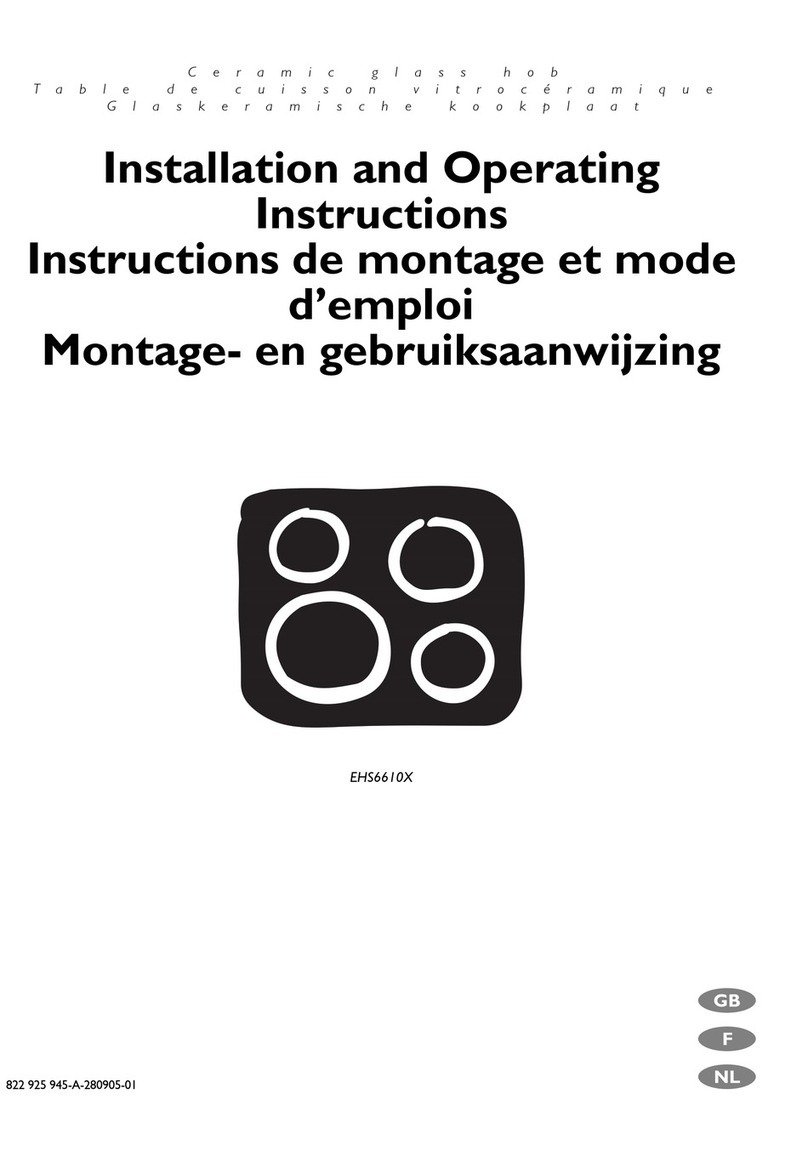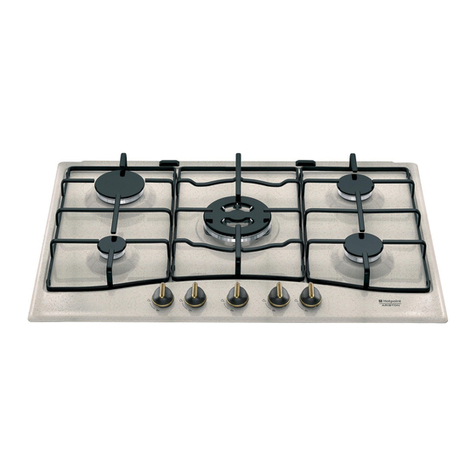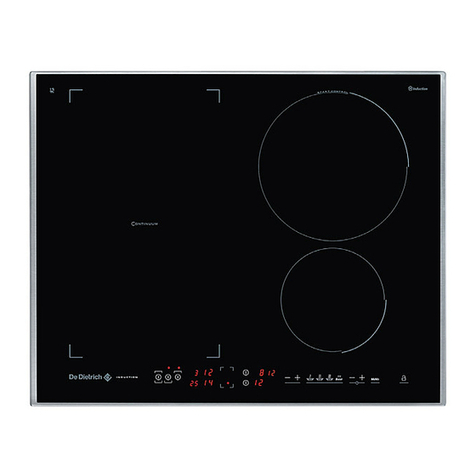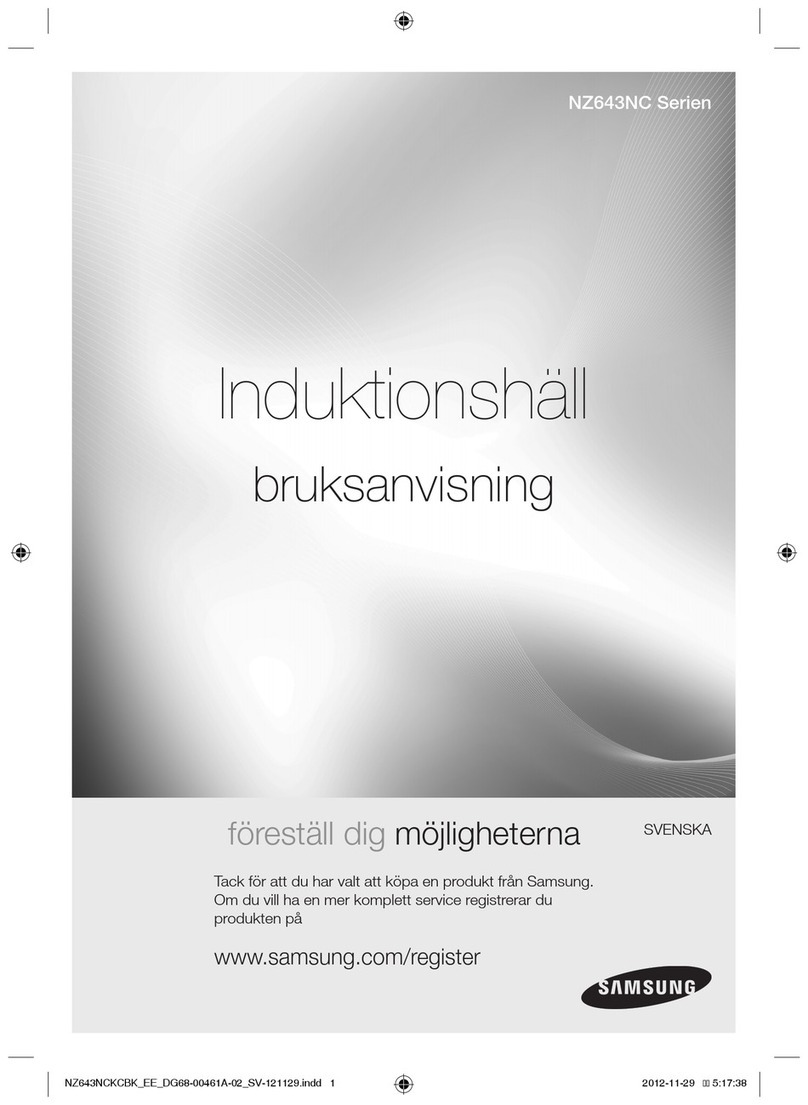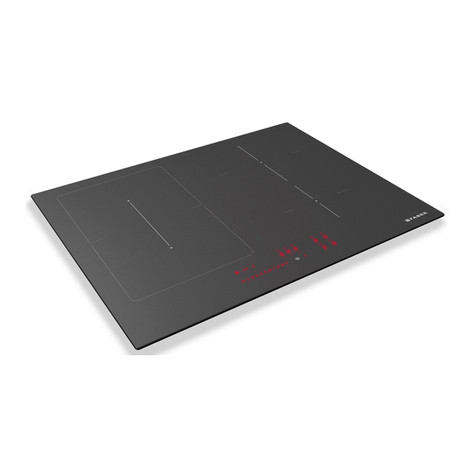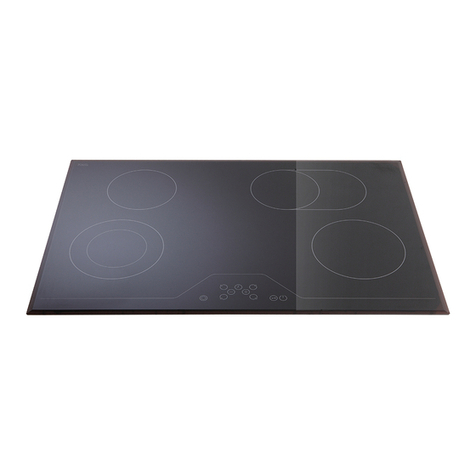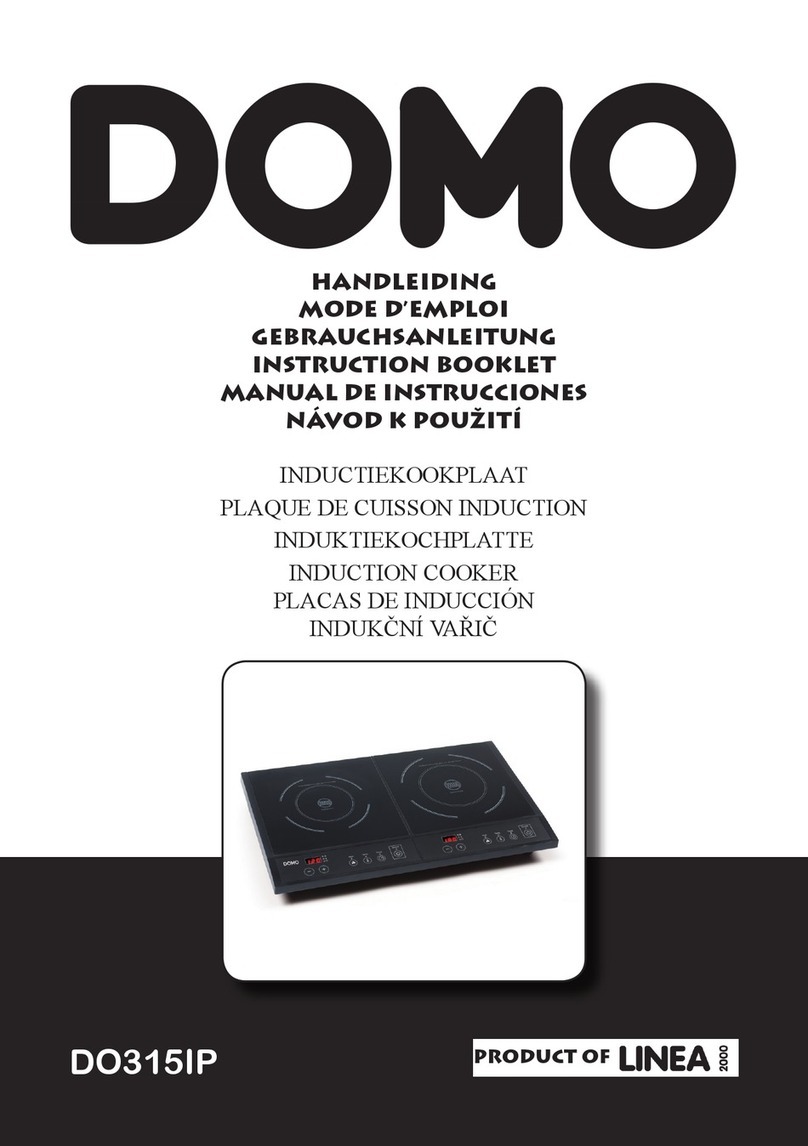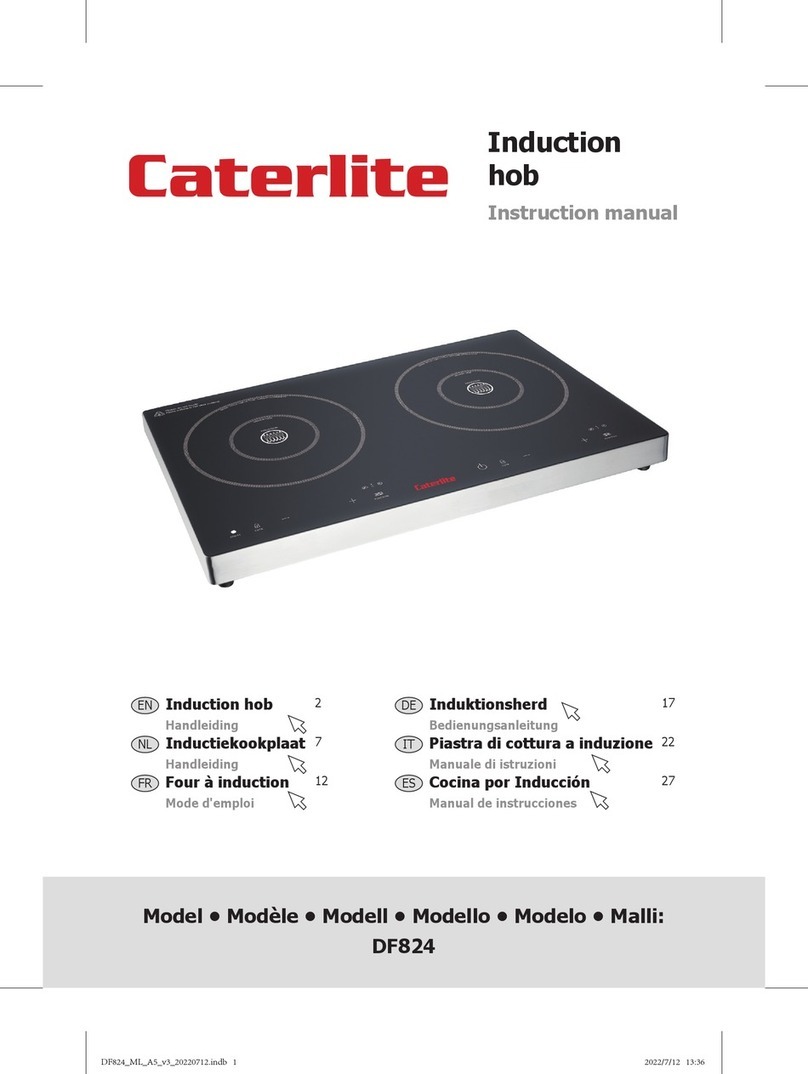Glem GTI640LWH User manual

IT
EN
DE
ES
FR
PIANO INDUZIONE VETROCERAMICO
- Istruzioni d'uso e manutenzione 5
INDUCTION VITROCERAMIC HOB
- Use and maintenance instructions 12
ELEKTRO GLASKERAMIK INDUKTIONS KOCHFELD
- Bedienungs und Wartungsanleitung 19
PLACA INDUCCION VIDRIOCERAMICA
- Instrucciones de uso y mantenimiento 26
TABLE INDUCTION VETROCERAMIQUE
- Instructions pour l’utilisation et manutention 33
Assorbimento / Absorption / Anschlusswert : 7,2 kW Fig. A
w 1200
@ 9 POWER
(W 1600
@ BOOSTER)
Ø 145
Ø 210
Ø 210
Ø 145
W 1500
@ 9 POWER
(W 2000
@ BOOSTER)
W 1200
@ 9 POWER
(W 1600
@ BOOSTER)
W 1500
@ 9 POWER
(W 2000
@ BOOSTER)

3
576
506
470
526
55
480
560
min. 50 mm
54 mm
20 mm
Fig.3
Fig.4
Fig.2
Ⓐ
Ⓑ
Fig.E
~ 2 mm
30 mm
54 mm
40 mm
54 mm
Fig.1

4
F
FE
B
A
D
C
Fig.8Fig.9
Fig. 6Fig.7
Ⓐ
Ⓑ
Fig.5

5
Staccare l’apparecchio dalla rete elettrica.
• ATTENZIONE: Se il cavo di alimentazione
dell’apparecchio è danneggiato deve
essere sostituito dal produttore, dal servizio
assistenza autorizzato o da personale
qualicato al ne di evitare rischi.
• ATTENZIONE: L’apparecchio e le sue parti
accessibili diventano caldi durante l’uso.
Si deve prestare attenzione per evitare di
toccare gli elementi riscaldanti.
• ATTENZIONE: La cottura con olio o grasso
può essere pericolosa e può provocare
incendi. Non utilizzare MAI acqua per
cercare di spegnere il fuoco. Soocare le
amme ad es. con un coperchio, un panno
da cucina umido o simili.
• ATTENZIONE: Il piano di cottura è molto
caldo quando è in funzione e rimane caldo
anche per un certo tempo dopo averlo
spento. Il rischio di ustione non sussiste
più solo quando si spengono le spie del
calore residuo.
• ATTENZIONE: Il normale processo di
cottura deve essere sorvegliato. Un
processo di cottura di breve durata deve
essere sorvegliato continuamente. Pentole
dalle quali evaporano completamente i
liquidi possono provocare danni al piano in
vetroceramica. Grasso o olio surriscaldati
possono iniziare a bruciare e provocare un
incendio.
• PERICOLODIINCENDIO!Non conservare
oggetti sulle superci di cottura! Oggetti
metallici quali coltelli, forchette, cucchiai
e coperchi non devono essere posti sulla
supercie del piano di cottura in quanto
possono surriscaldarsi.
• Spegnere sempre le zone di cottura dopo
l’uso!
• L’apparecchio non è destinato ad essere
utilizzato per mezzo di un timer esterno
o un sistema di comando a distanza
separato.
ISTRUZIONI PER L’INSTALLAZIONE
Le presenti istruzioni sono rivolte ad un
installatore specializzato e fungono da
guida per l’installazione, la regolazione e
la manutenzione in conformità delle leggi
e delle norme vigenti. Se un forno da
incasso o qualsiasi altra apparecchiatura
PIANO VETROCERAMICA
Istruzioni per l’uso
Leggere attentamente il contenuto del
presente libretto inquanto fornisce importanti
indicazioni riguardanti la sicurezza di
installazione, d’uso e di manutenzione.
Conservare il libretto per ogni ulteriore
consultazione.
Tutte le operazioni relative all’installazione
(connessioni elettriche) devono essere
eettuate da personale specializzato in
conformità delle norme vigenti.
AVVERTENZE PER LA SICUREZZA
• Il piano di cottura deve essere utilizzato
sempre nei limiti del normale uso domestico
per preparare e tenere in caldo le pietanze.
Qualsiasi altro impiego non è ammesso.
• Le persone che per le loro capacità
siche, sensoriali o psichiche o per la loro
inesperienza o non conoscenza non siano
in grado di utilizzare in sicurezza il piano
di cottura, non devono farne uso senza
la sorveglianza e la guida di una persona
responsabile.
• I bambini sotto gli 8 anni di età devono
essere tenuti lontani dal piano di cottura
a meno che non siano sotto controllo
costante di un adulto.
• I bambini al di sopra degli 8 anni possono
eventualmente utilizzare l’apparecchio
da soli, se sono in grado di usarlo
correttamente. È importante che sappiano
riconoscere i pericoli che possono derivare
da un uso non corretto.
• Non permettere ai bambini di giocare con
l’apparecchio.
• I bambini non devono eettuare operazioni
di pulizia o manutenzione del piano di
cottura a meno che non siano sotto la
supervisione di un adulto.
• Lavori di installazione e manutenzione,
nonché riparazioni, devono essere
eseguiti da personale specializzato. Lavori
o riparazioni non correttamente eseguiti
possono creare seri pericoli per l’utente.
•PERICOLO DI SCOSSA ELETTRICA!
Non mettere in funzione o spegnere
subito il piano di cottura se la lastra in
vetroceramica è danneggiata o crepata.
IT
PIANO INDUZIONE VETROCERAMICO
Istruzioni per l’uso
IT

6
che genera calore deve essere montato
direttamente sotto il piano di cottura in
vetroceramica, È NECESSARIO CHE TALE
APPARECCHIATURA (forno) E IL PIANO
DI COTTURA IN VETROCERAMICA
SIANO ADEGUATAMENTE ISOLATI, in
modo tale che il calore generato dal forno,
misurato sul lato destro del fondo del piano
di cottura, non superi i 60°C. Il mancato
rispetto di tale precauzione potrebbe
determinare l’errato funzionamento del
sistema TOUCH CONTROL.
POSIZIONAMENTO
L’elettrodomestico è realizzato per essere
incassato in un piano di lavoro, come
illustrato nella gura (Fig.1). Predisporre
materiale sigillante (Fig.4) lungo l’intero
perimetro (dimensioni del taglio (Fig.1).
Bloccare l’elettrodomestico sul piano di
lavoro mediante i 4 sostegni, tenendo
presente lo spessore del piano di lavoro
(Fig.2). Se la parte inferiore dell’apparecchio,
dopo l’installazione, è accessibile dalla parte
inferiore del mobile è necessario montare un
pannello separatore rispettando le distanze
indicate (Fig.3); se si installa sotto un forno
questo non è necessario.
VENTILAZIONE
La distanza tra il piano di cottura e i mobili
da cucina o gli apparecchi da in casso deve
essere tale da garantire una suciente
ventilazione ed un suciente scarico
dell’aria. Non utilizzare il piano di cottura se
nel forno è in corso il processo di pirolisi.
CONNESSIONI ELETTRICHE (Fig.5)
Prima di eettuare le connessioni elettriche
assicurarsi che:
-le caratteristiche dell’impianto siano tali
da soddisfare le indicazioni sulla targhetta
identicativa applicata sulla parte inferiore
del piano di lavoro;
-l’impianto sia dotato di una messa a terra
eciente conforme alle norme e alle
disposizioni di legge in vigore.
La messa a terra è obbligatoria per legge.
Nel caso in cui l’elettrodomestico non sia
dotato di cavo e/o della relativa spina,
utilizzare materiale adatto per l’assorbimento
indicato nella targhetta identicativa e
per la temperatura di funzionamento. Se
si desidera una connessione diretta alla
linea elettrica, è necessario interporre un
interruttore omnipolare, con un’apertura
minima di 3mm fra i contatti, appropriato al
carico indicato nella targhetta e conforme
alle norme vigenti (il conduttore di terra
giallo/verde non deve essere interrotto dal
commutatore). Terminata l’installazione
dell’apparecchiatura, l’interruttore
omnipolare deve essere facilmente
raggiungibile.
USO E MANUTENZIONE
La caratteristica fondamentale del sistema
ad induzione è il trasferimento diretto
dell’energia riscaldante dal generatore al
recipiente di cottura.
Vantaggi:
-Il trasferimento di energia avviene solo
quando il recipiente è posto sulla zona di
cottura.
-Il calore viene generato solo sul fondo del
recipiente e trasmesso direttamente al cibo
da cuocere.
-Tempi di riscaldamento ridotti e basso
consumo di energia durante l’inizio cottura,
consentono un risparmio globale di
energia.
-Il piano in vetroceramica rimane freddo. Il
calore che si avverte sul piano di cottura è
quello riesso dal fondo del recipiente.
RECIPIENTI PER LA COTTURA
L’utilizzo di recipienti appropriati è un fattore
essenziale per la cottura ad induzione.
Vericate che le vostre pentole siano idonee
per il sistema ad induzione.
I recipienti devono quindi contenere
ferro.
Potete vericare se il materiale della pentola
è magnetico con una semplice calamita
(Fig.6).
Si consigliano recipienti a fondo piatto
(Fig.7A).
Non utilizzare recipienti con base ruvida, per
evitare di graare la supercie termica del
piano. In questo modo l’energia può essere
utilizzata in modo ottimale. Un fattore non
trascurabile nella cottura ad induzione sono

7
inne le dimensioni della pentola in relazione
alla piastra utilizzata (Fig.7B).
Le zone di cottura consentono l’utilizzo
di recipienti con fondi di vari diametri. E’
comunque preferibile utilizzare la zona di
cottura appropriata al diametro della pentola
che si vuole utilizzare.
DIAMETRO
ZONA COTTURA
DIAMETRO
MINIMO PENTOLA
Ø 145 mm 80 mm
Ø 210 mm 130 mm
USO (Fig.8)
F
FE
B
A
D
C
A- Tasto ON/OFF > accende e/o spegne
l’apparecchio
B- Tasto di blocco > attiva il blocco
comandi / sicurezza bambini
C- Tasto + > aumenta la potenza di cottura
D- Tasto - > riduce la potenza di cottura
E- Display zona > mostra i valori impostati
sulla zona di cottura
F - Zona di cottura > attiva la zona di
cottura desiderata
ACCENSIONE PIANO COTTURA
Per accendere l’apparecchio premere
il tasto , i display si accenderanno in
posizione standby .
L’unità di controllo rimarrà attiva per un
tempo di 10 secondi. Se entro questo
termine non verrà selezionata nessuna
zona di cottura il piano cottura si spegnerà
automaticamente.
ACCENSIONE ZONE COTTURA
Per selezionare la zona di cottura desiderata
premere il relativo tasto e premere entro 10
secondi il tasto o il tasto per regolarne
la potenza. La potenza della singola zona
di cottura può essere regolata in 9 dierenti
livelli, più la funzione di Booster (vedi cap.
“Riscaldamento veloce/Power boost”).
e sarà visualizzata nel relativo display
luminoso con un numero da “1a 9”, mentre
la funzione di Boost sarà visualizzata con
GESTIONE POTENZA
Alla prima accensione il livello di potenza
massima predenito impostato sul piano
di cottura è di 2800W. Questo livello di
potenza può essere ridotto dall’utente a
1000W, 1600W, 2200W, oppure aumentato
a 3500W, 6000W, 7200W.
Ogni volta che l’utente cerca di aumentare
la potenza di una zona di cottura, viene
calcolata la potenza totale in uso in quel
momento di tutto il piano.
L’aumento della potenza della zona di
cottura è possibile solo nel caso in cui la
potenza totale in uso nel piano non superi
il livello di potenza massima predenito. In
caso contrario l’aumento di potenza per la
zona di cottura non sarà possibile, verrà
emesso un segnale acustico e sul display
comparirà la lettera ‘r’ per circa 3 secondi.
La potenza delle singole zone di cottura è
illustrata in Fig.A (pag.2).
Per esempio se il livello di potenza
massima disponibile è a 1000W, i livelli
impostabili massimi sono:
Solo una
zona
grande
attiva
1 o 3
Solo una
zona
piccola
attiva
2 o 4
Una zona
cottura
grande
e una
piccola
attive
Due zone
di cottura
piccole
attive
Livello
massimo
consentito 6 8 5+3 5+5

8
A) Per impostare un diverso livello di
potenza superiore a 2800W:
1. Spegnereilpianocotturaedisconnetterlo
dalla rete elettrica.
2. Riconnettere il piano. Premere il tasto
per disattivare l’eventuale blocco
comandi.
3. Premere contemporaneamente i tasti di
selezione delle zone di cottura 2 e 4
(vedi gura sottostante). Verrà emesso
un segnale acustico e nei due display
superiori comparirà il livello di potenza
massima attualmente impostato nel piano
di cottura.
4. Selezionare il livello di potenza desiderato
tramite i tasti
e .
I livelli di potenza disponibili sono
2800W,
3500W, 6000W e 7200W.
5. Per confermare la selezione premere
contemporaneamente il tasto delle
zone di cottura 2 e 4. Questa operazione
deve essere eettuata entro 60 secondi,
in caso contrario i settaggi verranno
annullati.
B) Per impostare un diverso livello di
potenza inferiore a 2800W:
1. Spegnereilpianocotturaedisconnetterlo
dalla rete elettrica.
2. Riconnettere il piano. Premere il tasto
per disattivare l’eventuale blocco
comandi.
3. Premere contemporaneamente i tasti di
selezione delle zone di cottura 1 e 3
(vedi gura sottostante). Verrà emesso
un segnale acustico e nei due display
superiori comparirà il livello di potenza
minima attualmente impostato nel piano di
cottura.
4. Selezionare il livello di potenza desiderato
tramite i tasti
e .
I livelli di potenza disponibili sono
1000W,
1600W, 2200W e 2800W.
5. Per confermare la selezione premere
contemporaneamente il tasto delle
zone di cottura 1 e 3. Questa operazione
deve essere eettuata entro 60 secondi,
in caso contrario i settaggi verranno
annullati.
2
41
3
PROCEDURE DI REGOLAZIONE
DELL’ ASSORBIMENTO MASSIMO

9
RISCALDAMENTO VELOCE /
POWER BOOST
Questa funzione riduce ulteriormente il
tempo di cottura di una data zona portando
la temperatura alla massima potenza per un
intervallo di 10 minuti. Al termine di questo
intervallo la potenza della zona di cottura
torna automaticamente al livello 9.
L’uso di questa funzione è indicato per il
riscaldamento in tempi brevissimi di grandi
quantità di liquidi (es. acqua per la cottura
della pasta) o pietanze. Per attivare questa
funzione selezionare la zona di cottura e
premere il tasto no al livello 9. Premere
nuovamente il tasto . Verrà emesso un
segnale acustico ed il simbolo sarà
visualizzato nel display relativo alla zona.
CALORE RESIDUO
Se la temperatura di una zona di cottura
è ancora elevata (superiore a 50°) dopo
essere stata spenta, il display relativo a
quella zona mostra il simbolo (calore
residuo). L’indicazione scompare solo
quando non vi è più alcun rischio di ustioni.
RICONOSCIMENTO PENTOLE
Se su uno dei display di una zona di cottura,
dovesse comparire il simbolo , signica
che:
1)il recipiente utilizzato non è idoneo per la
cottura ad induzione.
2)ildiametrodellapentolautilizzataèinferiore
a quello consentito dall’apparecchio.
3)sulla piastra non è presente nessuna
pentola.
TIMER
Questa funzione permette di stabilire il tempo
(da a minuti) per lo spegnimento
automatico della zona di cottura selezionata.
Attivare una zona cottura premendo uno
dei tasti Fe regolare la potenza tramite
i tasti C o D.Per attivare il timer premere
nuovamente il tasto F relativo alla zona
selezionata, verrà emesso un segnale
acustico e la ‘t’ comparirà nel display della
zona selezionata. Regolare il tempo tramite
i tasti C e D. Se la zona cottura selezionata
si trova nella parte inferiore del piano il
tempo timer verrà mostrato nel display della
zona cottura situata nella parte superiore del
piano e viceversa. Premere di nuovo il tasto
Fper confermare. Allo scadere del timer la
zona cottura si spegnerà automaticamente
e verrà emesso un segnale acustico. Per
disattivare il timer premere il tasto Fdella
zona precedentemente abilitata e portare a
il valore del timer tramite il tasto D.
BLOCCO COMANDI
Il tasto blocca il funzionamento del piano
nello stato in cui si trova, impedendo ogni
operazione non intenzionale (es. da parte di
bambini). In questo stato nessuna azione
sui tasti ha eetto.
Per attivare la funzione di sicurezza premere
il tasto no all’accensione della spia.
Quando il blocco dei comandi è attivo è
comunque possibile spegnere il piano di
cottura. In questo caso il blocco comandi
rimane attivo anche alla riaccensione del
piano.
Per disattivare il blocco dei comandi premere
il tasto no allo spegnimento della spia.
SPEGNIMENTO ZONE COTTURA
Per spegnere una zona di cottura
selezionarla premendo il relativo tasto poi
premere contemporaneamente i tasti e
oppure il tasto no alla posizione .
SPEGNIMENTO PIANO COTTURA
Per spegnere completamente il piano di
cottura premere il tasto .
SPEGNIMENTO DI SICUREZZA
L’apparecchio è provvisto di un sistema di
sicurezza che spegne automaticamente la
zona di cottura trascorso il tempo limite di
accensione ad una data potenza.
POTENZA TEMPO LIMITE
ACCENSIONE (ore)
1 - 8 10
9 3
PULIZIA E MANUTENZIONE
Rimuovere eventuali residui di cibo e gocce
di unto dalla supercie di cottura utilizzando
lo speciale raschietto fornito su richiesta
(Fig.9).

10
Pulire l’area riscaldata nel miglior modo
possibile utilizzando prodotti idonei ed
un panno-carta, quindi sciacquare con
acqua e asciugare con un panno pulito.
Mediante lo speciale raschietto rimuovere
immediatamente dall’area riscaldata di
cottura frammenti di fogli di alluminio e
materiale plastico scioltisi inavvertitamente
o residui di zucchero o di cibi ad elevato
contenuto di zucchero. In questo modo si
evita ogni possibile danno alla supercie del
piano. In nessun caso si devono utilizzare
spugnette abrasive o detergenti chimici
irritanti quali spray per forno o smacchiatori.
ATTENZIONE: NON DEVE ESSERE
UTILIZZATO UN PULITORE A VAPORE.
DISMISSIONE DEGLI
ELETTRODOMESTICI
La direttiva Europea 2002/96/CE
sui riuti di apparecchiature
elettriche ed elettroniche (RAEE),
prevede che gli elettrodomestici
non debbano essere smaltiti nel
normale usso dei riuti solidi urbani. Gli
apparecchi dismessi devono essere raccolti
separatamente per ottimizzare il tasso di
recupero e riciclaggio dei materiali che li
compongono ed impedire potenziali danni
per la salute e l’ambiente. Il simbolo del
cestino barrato è riportato su tutti i prodotti
per ricordare gli obblighi di raccolta separata.
Per ulteriori informazioni, sulla corretta
dismissione degli elettrodomestici, i
detentori potranno rivolgersi al servizio
pubblico preposto o ai rivenditori.
SI DECLINA OGNI RESPONSABILITÀ PER
EVENTUALI DANNI PROVOCATI DALLA
INOSSERVANZA DELLE SUDDETTE
AVVERTENZE.
LA GARANZIA NON É VALIDA NEL
CASO DI DANNI DERIVANTI DALLA
INOSSERVANZA DELLE SUDDETTE
AVVERTENZE.

11
23
4
1
4
179,9
1. = Ø 210
3. = Ø 210
4. = Ø 145
1. = 183,40
2. = 176,40
3. = 183,40
4. = 176,40
2. = Ø 145
mm
Wh/kg
Wh/kg
Identificativo del modello
Tipologia di piano cottura
Numero di zone e/o aree di cottura
Informazioni sui piani di cottura elettrici a uso domestico
ai sensi del regolamento (UE) n. 66/2014
Consumo energetico del piano cottura calcolato per kg
electric hob Wh/kg
Tecnologia di riscaldamento
Zone di cottura e aree di cottura a induzione, zone di
cottura radianti.
Consumo energetico per zona o area di cottura
calcolato al kg (EC
Per le zone di cottura elettriche circolari: diametro della
superficie utile.
Per zone o aree di cottura non circolari: lunghezza/
larghezza della superficie/zona di cottura utile L/W.
Consumo energetico del piano cottura calcolato per kg
(EC
electric cooking
(EC
)
)
incassato
1. = Induzione
2. = Induzione
3. = Induzione
4. = Induzione

12
GLASS CERAMIC HOB
User instructions
Carefully read the contents of this leaet
since it provides important instructions
regarding safety of installation, use
and maintenance. Keep the leaet for
possible future consultation. All the
operations relating to installation (electrical
connections) must be carried out by
specialised personnel in accordance with
current regulations.
SAFETY WARNINGS
• Use the cooktop only in household-type
situations for the preparation and warming
of food. All other types of use are not
permitted.
• Individuals who are incapable of using the
appliance safely because of their physical,
sensory or mental capabilities or their lack of
experience or knowledge must not use this
appliance without supervision or instruction
by a responsible person.
• Children under 8 years of age must be kept
away from the cooktop unless they are
under constant supervision.
• Children 8 years and older must only be
allowed to use the cooktop if they have been
given supervision or instruction concerning
use of the appliance in a safe way and
understand the hazards involved.
• Children shall not play with the appliance.
• Cleaning and user maintenance shall not be
made by children without supervision.
• Installation, repair and maintenance work
should only be performed by an authorized
service technician. Work by unqualied
people could be dangerous for the user.
• RISK OF ELECTRIC SHOCK! If the
cooktop is defective or chipped, cracked or
broken in any way, immediately switch it o
and do not continue to use it. Disconnect it
from the electrical power supply.
• WARNING: If the supply cord of the
appliance is damaged, it must be replaced by
the manufacturer, its service agent or similarly
qualied people in order to avoid a hazard.
• WARNING: The appliance and its
accessible parts become hot during use.
Care should be taken to avoid touching
heating elements.
•WARNING: Unattended cooking on a hob
with fat or oil can be dangerous and may
result in re. NEVER try to extinguish a
re with water, but switch o the appliance
and then cover ame e.g. with a lid or a re
blanket.
• WARNING: The cooktop is hot during use
and remains so for some time after being
switched o. The risk of burns remains until
the residual heat indicators have gone out.
• CAUTION: The cooking process has to be
supervised. A short term cooking process
has to be supervised continuously.
• DANGER OF FIRE: Do not store items on
the cooking surfaces! Metallic objects such
as knives, forks, spoons and lids should not
be placed on the hob surface since they can
become hot.
• Always switch the cooking zones o after
use!
• The appliance is not intended to be operated
by means of an external timer or separate
remote-control system.
INSTALLATION INSTRUCTIONS
These instructions are for a specialized
installer and are a guide for the installation
process, regulations and maintenance
in accordance with the law and current
standards.
If the built-in oven or any other appliances
that produce heat, need to be installed
directly underneath the cooking hobs in
ceramic glass, IT IS NECESSARY THAT
THE APPLIANCE (oven) AND THE
COOKING HOBS IN CERAMIC GLASS
ARE ADEQUATELY ISOLATED, in such
a way that the heat generated from the
oven, measured on the right hand side of
the bottom of the cooking hobs, does not
exceed 60°C.
Failure to follow this precaution, could
cause a malfunction in the TOUCH
CONTROL system.
EN
INDUCTION VITROCERAMIC HOB
User instructions
EN

13
POSITIONING
The domestic appliance was built in order to
be encased on a work surface, the way it is
illustrated in the graph (Fig.1). Predispose
sealing material (Fig.4) along the whole
perimeter (for dimensions of the cut see
Fig.1). Lock the domestic appliance into
place with 4 supporters, keeping in mind
the width of the surface (Fig.2).
If the lower part of the appliance after
installation, is accessible via the lower part
of the furniture, it is necessary to mount
a separating panel keeping in mind the
distances indicated (Fig.3). This is not
necessary if underneath the induction hob
is installed an oven.
VENTILATION
The distance between the cooktop and
built-in kitchen’s furniture or cooking
apparatuses must guarantee sucient
ventilation of the air. Not to use the cooktop
if in the oven is in course the pyrolysis
process.
ELECTRICAL CONNECTIONS (Fig.5)
Before making the electrical connections,
check that:
- the system ratings meet those indicated
on the identication plate xed on the lower
part of the worktop;
- the system is tted with ecient ground
wires in accordance with the laws and
current standards.
Grounding is mandatory by law.
If the domestic appliance is not supplied
with a cable and/or suitable plug, use
material suitable for the absorption value
indicated on the identication plate and
the operating temperature. If wishing to
make a direct connection to the mains,
an omnipolar switch must be installed
with a minimum 3 mm opening between
the contacts and appropriate for the load
indicated on the plate and in accordance
with current standards (the yellow/green
groundconductormust notbedisconnected
by a switch). When the appliance has been
installed, the omnipolar switch must be
easily reachable.
USE AND MAINTENANCE
The fundamental characteristic of the
induction system is the direct transference
of heat from the generator to the cooking
recipient.
Advantages:
-The transference of power takes place
only when the recipient is placed on the
cooking zone.
-The heat is generated only at the base
of the recipient and transferred directly to
the food to be cooked.
- Reduced heating time and low
consumption of power during the
beginning of cooking, allowing a global
saving of power.
-The vitroceramic top remains cold,
the heat felt on the cooking top is that
reected from the base of the recipient.
COOKING RECIPIENTS
The use of appropriate recipients is an
essential factor for induction cooking.
Check that your pots are suitable for the
induction system. The recipients must
contain iron. You can check whether the
material of the pot is magnetic with a simple
magnet (Fig.6). We advise recipients
having a at base (Fig.7A). This way you
can use the power optimally.
Do not use recipients with a rough base
to avoid scratching the thermal surface of
the top.
A very important factor in induction cooking
is the dimension of the pot compared to
the plate used (Fig.7B).
The cooking zones allow the use of
recipients with bases of various diameters.
It is, however, preferable to use the
appropriate cooking zone for the dimension
of the pot.

14
COOKING ZONE
DIAMETER MINIMUM PAN
DIAMETER
Ø 145 mm 80 mm
Ø 210 mm 130 mm
USE (Fig.8)
F
FE
B
A
D
C
A- ON/OFF key > switch the appliance on
and o
B- Lock key > activate control panel lock /
child lock
C- Plus key > increase power level of the
cooking zone
D- Minus key > reduce power level of the
cooking zone
E- Display area > shows the values set for
the cooking zone
F-Cooking Zone >select and activate the
desired cooking zone
SWITCHING THE HOB ON
Press the on-o key to switch the
appliance on. The displays will turn on in
the stand-by position.
The control unit remains active for 10
seconds.
If no cooking zone is selected within
this time, the cooking top switches o
automatically.
SWITCHING THE COOKING ZONE
ON
Press the relative key to select the
desired cooking zone and press the
or
key within 10 seconds to set the power
level.
The power of the single cooking zone can
be adjusted in 9 dierent positions and will
be shown on luminous display Bwith a
number from “1 to 9”.
POWER MANAGEMENT
The default cooktop maximum power limit
is 2800W. This power limit can be reduced
by the user to 1000W, 1600W or 22000W,
or increased to 3500W, 6000W, 7200W.
Each time the user tries to increase the
power of a cooking zone, the currently
active total power level of the cooktop is
calculated.
If this total power level is greater than the
cooktop maximum power limit, the power
increase of the cooking zone is not allowed.
An error beep sounds and the cooking
zone display shows an ‘r’ for 3 seconds.
The single cooking zone power is shown
in Fig. A (page 2).
For example, if the available maximum
power level is 1000W, the maximum
adjustable levels are:
Only one
large
active
zone
1 or 3
Only one
small
active
zone
2 or 4
One large
active
cooking
zone and
a small ac-
tive one
Two small
active
cooking
zones
Maximum
permitted
level 6 8 5+3 5+5

15
A) To set a dierent power limit greater
than 2800W:
1. Turn the cooktop o and disconnect it from
the electrical mains.
2. Reconnect the cooktop to the mains.
Press the key to unlock the cooktop.
3. Press at the same time the keys of the
cooking zones 2 and 4 (see Fig. below).
Once this is done, a beep sounds and
the actual cooktop maximum power limit
will be shown in the upper cooking zone
displays.
4. Select the new power limit using the
e
keys. Available congurations are 2800W,
3500W, 6000W or 7200W. .
5. To conrm the settings press at the same
time the keys of the cooking zones 2
and 4 within 60 seconds. If this operation
is not executed within this time the settings
will be cancelled.
B) To set a dierent power limit lower
than 2800W:
1. Turn the cooktop o and disconnect it from
the electrical mains.
2. Reconnect the cooktop to the mains.
Press the key to unlock the cooktop.
3. Press at the same time the keys of the
cooking zones 1 and 3 (see Fig. below).
Once this is done, a beep sounds and
the actual cooktop minimum power limit
will be shown in the upper cooking zone
displays.
4. Select the new power limit using the
e keys. Available congurations are
1000W, 1600W, 22000W or 2800W.
5. To conrm the settings press at the same
time the keys of the cooking zones 1
and 3 within 60 seconds. If this operation
is not executed within this time the settings
will be cancelled.
2
41
3
ADJUSTMENT PROCEDURES
MAXIMUM ABSORPTION

16
QUICK HEATING/POWER BOOST
This function further reduces cooking time
in a given area taking the temperature
to the maximum power for a 10 minute
interval. At the end of this interval, the
cooking area power automatically returns
to level 9.
The use of this function is recommended
for heating a large quantity of liquid in a
very short time (i.e. water for cooking
pasta) or other dishes.
To activate this function, select the cooking
area and press the key up to level 9.
Press the key again.
An acoustic signal will be emitted and a
symbol will be visualised on the display
E relative to the area.
RESIDUAL HEAT
If the temperature of the cooking area is still
high (over 50°) after it has been switched
o, the relative display will indicate the
symbol (residual heat). The symbol will
only switch o when the burn risk is no
longer present.
POT DETECTION
If the symbol
should appear on one of
the cooking area displays, it means that:
1) The recipient being used is not suitable
for induction cooking.
2) The diameter of the recipient used is
inferior to that allowed by the appliance.
3) No recipient is present.
TIMER
This function allows you to set the time
(from to minutes) to automatically
switch o of the selected cooking zone.
Select a cooking zone by pressing one of
the Fkeys and set the power by pressing
the Cor Dkeys.
To activate the timer press again the F key,
an acustic signal will be heard and the ‘‘t’’
symbol will appear on the display of the
selected cooking zone.
Set the time by pressing the Cor Dkeys.
If the cooking zone is in the lower part of
the cooktop the time will be shown on the
display of the cooking zone in the upper
part of the cooktop and vice versa. Press
the key F again to conrm your selection.
When the timer function elapses, the
cooking zone will automatically switch o
and an acoustic signal will be heard.
To disable the timer function, press the F
key on the cooking zone previously started,
bring the timer value back to by using
the Dkey, then press the Bkey again to
conrm your selection.
CONTROL PANEL LOCK
The key blocks the hob functioning,
in order to prevent any unintentional
operation (e.g. by children). In this state no
action on the keys has eect. To activate
the safety function, press the key until
the warning light switches on. The cooking
top can however be switched o even when
the controls block is activated. In this case
the controls block remains active when the
top is switched on again. To deactivate the
safety function press the key until the
warning light switches o.
SWITCHING THE COOKING ZONES
OFF
To switch a cooking zone o, press the
relative key to select it then press
simultaneously the
and key, or press
the key until reaching position .
SWITCHING THE HOB OFF
To turn o the cooking top entirely hold
down the key.
SAFETY SWITCH
The appliance has a safety switch that
automatically switches o the cooking
zones when they have been operating for
a certain amount of time at a given power
level.
POWER
LEVEL OPERATING TIME
LIMIT (hours)
1 - 8 10
9 3

17
MAINTENANCE
Remove any residues of food and drops
of grease from the cooking surface by
using the special scraper supplied on
request (Fig.9). Clean the heated area
as thoroughly as possible using suitable
products, and a cloth/paper, then rinse
with water and dry with a clean cloth.
Using the special scraper immediately
remove any fragments of aluminium and
plastic material that have unintentionally
melted on the heated cooking area, or
residues of sugar or food with a high
sugar content. In this way, any damage
to the cooktop surface can be prevented.
Under no circumstances should abrasive
sponges, or corrosive chemical detergents,
such as oven sprays or stain removers, be
used.
WARNING: STEAM CLEANERS MUST
NOT BE USED.
DISPOSAL OF OLD ELECTRICAL
APPLIANCES
The European Directive 2002/96/
EC on Waste Electrical and
Electronic Equipment (WEEE),
requires that old household
electrical appliances must not be
disposed of in the normal unsorted municipal
waste stream. Old appliances must be
collected separately in order to optimise the
recovery and recycling of the materials they
contain and reduce the impact on human
health and the environment. The crossed-out
dustbin symbol on the product reminds you
of your obligation regarding separated waste
collection. Consumers should contact their
local public service or their local dealer for
more information on the correct disposal of
exhausted household appliances.
THE MANUFACTURER DECLINES ALL
RESPONSIBILITY FOR EVENTUAL
DAMAGES CAUSED BY BREAKING THE
ABOVE WARNINGS.
THE WARRANTY IS NOT VALID IN
THE CASE OF DAMAGE CAUSED BY
FAILURE TO COMPLY WITH THE ABOVE
WARNINGS.

18
23
4
1
4
179,9
1. = Ø 210
3. = Ø 210
4. = Ø 145
1. = 183,40
2. = 176,40
3. = 183,40
4. = 176,40
2. = Ø 145
mm
Wh/kg
Wh/kg
Model name / identifier
built-in
1. = Induction
2. = Induction
3. = Induction
4. = Induction
Type of hob
Number of cooking zones and/or areas
Heating technology
Induction cooking zones and cooking areas, radiant cooking
zones.
For circular cooking zones: diameter of useful surface area/
cooking zone
For non-circular cooking zones or areas: length and width
of useful surface area per electric cooking zone or area
Energy consumption per cooking zone or area
calculated per kg (EC
electric cooking
Energy consumption for the hob calculated per kg
(EC
electric hob
)
)
Information for household electric hobs
In acc. with regulation (EU) No. 66/2014

19
ELEKTRO-GLASKERAMIK-INDUKTIONS-
KOCHFELD
Lesen Sie den Inhalt dieses Handbuchs,
da sie wichtige Informationen zur sicheren
Installation, Einsatz und Wartung zur
Verfügung stellt.
Halten Sie Anweisungen zum späteren
Nachschlagen.
Alle damit verbundenen Aufgaben
(elektrische Verbindungen) muss durch
geschultes Personal in Übereinstimmung mit
den Vorschriften durchgeführt werden.
SICHERHEITSHINWEISE
• Verwenden Sie das Kochfeld ausschließlich
im haushaltsüblichen Rahmen zum
Zubereiten und Warmhalten von Speisen.
Alle anderen Anwendungsarten sind
unzulässig.
• Personen, die aufgrund ihrer physischen,
sensorischen oder geistigen Fähigkeiten
oder ihrer Unerfahrenheit oder Unkenntnis
nicht in der Lage sind, das Kochfeld sicher
zu bedienen, müssen bei der Bedienung
beaufsichtigt werden.
• Kinder unter acht Jahren müssen vom
Kochfeld ferngehalten werden - es sei
denn, sie werden ständig beaufsichtigt.
• Kinder ab acht Jahren dürfen das Kochfeld
nur ohneAufsicht bedienen, wenn ihnen das
Gerät so erklärt wurde, dass sie es sicher
bedienen können. Kinder müssen mögliche
Gefahren einer falschen Bedienung
erkennen und verstehen können.
• Lassen Sie Kinder niemals mit dem Gerät
spielen.
• Kinder dürfen das Kochfeld nicht ohne
Aufsicht reinigen oder warten.
• Durch unsachgemäße Installations- und
Wartungsarbeiten oder Reparaturen
können erhebliche Gefahren für den
Benutzer entstehen. Der Hersteller haftet
nicht für diese Schäden.
• Stromschlaggefahr! Nehmen Sie das
Kochfeld bei einem Defekt oder bei
Brüchen, Sprüngen oder Rissen in der
Glaskeramikscheibe nicht in Betrieb bzw.
schalten Sie es sofort aus. Trennen Sie es
vom Stromnetz.
• ACHTUNG: Falls das Stromkabel
beschädigt ist, muss es vom Hersteller,
Kundendienst oder Fachpersonal ersetzt
DE
werden, um jede Gefahr zu verhindern.
• ACHTUNG: Das Gerät und die
zugänglichen Geräteteile werden während
des Betriebs heiß. Berühren Sie nicht die
Heizelemente.
• ACHTUNG: Öle und Fette können sich
bei Überhitzung entzünden. Löschen Sie
niemals Öl- und Fettbrände mit Wasser.
Schalten Sie das Gerät aus und ersticken
Sie die Flammen vorsichtig mit einem
Deckel oder einer Löschdecke.
• ACHTUNG: Das Kochfeld wird bei
Betrieb heiß und bleibt es noch einige
Zeit nach dem Ausschalten. Erst wenn
die Restwärmeanzeigen erloschen sind,
besteht keine Verbrennungsgefahr mehr.
• ACHTUNG: Lassen Sie das Kochfeld
während des Betriebs nicht unbeaufsichtigt.
Einen kurzfristigen Kochübergang ständig
überwachen. Leerkochende Töpfe können
zu Schäden an der Glaskeramikscheibe
führen. Öle und Fette können sich bei
Überhitzung entzünden.
• Brandgefahr: Verwenden Sie das Kochfeld
nicht als Ablageäche! Legen Sie keine
Metallgegenstände wie Messer, Gabeln,
Löel oder Topfdeckel auf die Oberäche
des Kochfelds, da diese heiß werden
können.
• Schalten Sie die Kochzonen nach Gebrauch
aus!
• Das Kochfeld ist nicht für den Betrieb mit
einer externen Zeitschaltuhr oder einem
Fernbedienungssystem bestimmt.
STROMANSCHLUSS
Die Anschlussschemata für die
verschiedenen Stromarten, Spannungen und
die einzusetzenden Kabel sind in Abbildung
5 (Abb.5) für den Fachmann eindeutig
dargestellt.
Vor dem elektrischen Anschluss ist
sicherzustellen, dass die Stromversorgung
einer der für das Glaskeramikfeld
vorgesehenen Stromarten und Spannungen
(Abb.6) entspricht.
Es ist ein entsprechend der Stromart und
der Spannung zugelassenes Anschlusskabel
zu verwenden, das den gesetzlichen
Vorschriften entspricht.
Das Glaskeramikfeld ist unbedingt zu erden.
Das Glaskeramikfeld ist unbedingt mit
einer Festanschlussdose anzuschließen.
ELEKTRO GLASKERAMIK INDUKTIONS
KOCH KOCHFELD
DE
Bedienungs und Wartungsanleitung

20
aus ferromagnetischem Material sein, d.h.
Eisen enthalten. Ob das Material Ihres
Kochgeschirrs ferromagnetisch ist, können
Sie ganz einfach mit einem Magneten
feststellen (Abb.7). Es wird empfohlen
Kochgeschirr aus Gusseisen, emalliertem
Stahl oder speziellem Edelstahl für das
Induktionskochen zu verwenden.
VORBEMERKUNGEN ZUR SICHERHEIT
• Personen, die einen Herzschrittmacher
tragen, sollten Ihren Arzt zu Rate ziehen,
bevor sie die Induktionskochäche
verwenden.
• Stellen Sie keine großen ferromagnetischen
Gegenstände (z.B. Backbleche) auf die
Glaskeramikkochäche.
• Nur Kochgeschirr mit ebenem und
ausreichend dickem Boden benutzen. Der
Boden muss wenigstens dem Durchmesser
der Kochzone entsprechen oder darf
höchstens leicht größer sein als diese.
(Abb.7)
• Das Kochgeschirr darf keinen rauen
Boden haben, um nicht die Glaskeramik zu
verkratzen.
• Die Kochzonen dürfen nicht aufgeheizt
werden, ohne dass ein gefülltes
Kochgeschirr darauf steht.
• Nichts direkt auf der heißen Kochzone ohne
Kochgeschirr braten oder grillen.
• Keine Gegenstände auf das Kochfeld legen.
• Darauf achten, dass das Kochgut nicht
überkocht und direkt auf die heiße Kochzone
läuft.
• Schalten Sie die Kochzone ab, bevor Sie
das Kochgeschirr vom Kochfeld nehmen.
REGELUNG (Abb.8)
F
FE
B
A
D
C
BEDIENUNGSSPERRE
Es besteht die Möglichkeit, die
Bedienungsfunktionen zu sperren, wodurch
die Gefahr von ungewollten Änderungen
der Kochfeldeinstellungen ausgeschlossen
Der Betrieb über einen Stecker und eine
Steckdose ist nicht zulässig. Es ist bei diesem
Festanschluss eine allpolige Trennvorrichtung
mit einer Kontaktönungsweite von
mindestens 3 mm vorzusehen.
Die Erdleitung darf nicht durch den Schalter
unterbrochen werden. Dieser Hauptschalter
muss jederzeit gut zugänglich sein.
Die Kabelführung ist so zu wählen, dass
sich das Kabel an keinem Punkt über 50°C
über Zimmertemperatur erwärmen kann. Bei
unsachgemäßem Anschluss ist jede Haftung
des Herstellers ausgeschlossen
MONTAGEABLAUF
Zwischen dem Gerät und der Arbeitsplatte ist
auf dem gesamten Umfang das mitgelieferte
Dichtungsband anzubringen (Abb.4). Diese
Dichtung verhindert das Eindringen von
Flüssigkeit zwischen dem Glaskeramikfeld
und der Arbeitsplatte.
Die Befestigung des Glaskeramikfeldes im
Ausschnitt der Arbeitsplatte erfolgt mit den
mitgelieferten Klammern (Abb. 2). Durch
Drehen der Klammern kann die Montage
alternativ in Arbeitsplatten mit der Stärke 30
mm oder 40 mm ausgeführt werden.
GEBRAUCH
VORBEMERKUNGEN ZUM
INDUKTIONSKOCHEN
Die wesentliche Eigenschaft des
Induktionssystems ist die direkte Übertragung
der Energie zum Erhitzen der Speisen von
der Induktionsquelle auf das Kochgeschirr.
Vorteile:
• Die Energieübertragung geschieht nur
dann, wenn ein Topf auf der Kochäche
steht.
• Die Wärme wird nur am Topfboden erzeugt
und direkt auf die zu garenden Speisen
übertragen.
• Kürzere Erwärmungszeiten und
geringerer Stromverbrauch zu Beginn
der Garzeit erlauben insgesamt eine
Energieeinsparung.
• Die Glaskeramikäche bleibt kalt. Auf dem
Kochfeld wahrgenommen wird nur die
Wärme, die von dem Boden des Topfes
reektiert wird.
• Vergewissern Sie sich bitte, dass Ihr
Kochgeschirr für das Induktionssystem
geeignet ist. Die Töpfe und Pfannen müssen
Table of contents
Languages:
Other Glem Hob manuals

